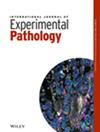Transient atrial inflammation in a murine model of Coxsackievirus B3‐induced myocarditis
IF 2.2
4区 医学
Q3 PATHOLOGY
引用次数: 3
Abstract
Atrial dysfunction is a relatively common complication of acute myocarditis, although its pathophysiology is unclear. There is limited information on myocarditis‐associated histological changes in the atria and how they develop in time. The aim of this study therefore was to investigate inflammation, fibrosis and viral genome in the atria in time after mild CVB3‐induced viral myocarditis (VM) in mice. C3H mice (n = 68) were infected with 105 PFU of Coxsackievirus B3 (CVB3) and were compared with uninfected mice (n = 10). Atrial tissue was obtained at days 4, 7, 10, 21, 35 or 49 post‐infection. Cellular infiltration of CD45+ lymphocytes, MAC3+ macrophages, Ly6G+ neutrophils and mast cells was quantified by (immuno)histochemical staining. The CVB3 RNA was determined by in situ hybridization, and fibrosis was evaluated by elastic van Gieson (EvG) staining. In the atria of VM mice, the numbers of lymphocytes on days 4 and 7 (p < .05) and days 10 (p < .01); macrophages on days 7 (p < .01) and 10 (p < .05); neutrophils on days 4 (p < .05); and mast cells on days 4 and 7 (p < .05) increased significantly compared with control mice and decreased thereafter to basal levels. No cardiomyocyte death was observed, and the CVB3 genome was detected in only one infected mouse on Day 4 post‐infection. No significant changes in the amount of atrial fibrosis were found between VM and control mice. A temporary increase in inflammation is induced in the atria in the acute phase of CVB3‐induced mild VM, which may facilitate the development of atrial arrhythmia and contractile dysfunction.柯萨奇病毒B3诱导的心肌炎小鼠模型中一过性心房炎症
心房功能障碍是急性心肌炎较为常见的并发症,但其病理生理机制尚不清楚。关于心肌炎相关的心房组织学改变及其如何及时发展的信息有限。因此,本研究的目的是及时研究小鼠轻度CVB3诱导的病毒性心肌炎(VM)后心房的炎症、纤维化和病毒基因组。用105 PFU柯萨奇病毒B3 (CVB3)感染C3H小鼠(n = 68),与未感染小鼠(n = 10)进行比较。在感染后4、7、10、21、35或49天获得心房组织。免疫组化染色测定CD45+淋巴细胞、MAC3+巨噬细胞、Ly6G+中性粒细胞和肥大细胞的浸润情况。采用原位杂交法检测CVB3 RNA,采用弹性van Gieson (EvG)染色法评价纤维化程度。VM小鼠心房淋巴细胞数量第4、7天(p < 0.05)和第10天(p < 0.01);第7天(p < 0.01)和第10天(p < 0.05);第4天中性粒细胞(p < 0.05);与对照组相比,第4、7天肥大细胞数量显著增加(p < 0.05),随后降至基础水平。未观察到心肌细胞死亡,并且在感染后第4天仅在一只感染小鼠中检测到CVB3基因组。VM小鼠和对照组小鼠心房纤维化数量无明显变化。在CVB3诱导的轻度VM急性期,心房炎症暂时增加,这可能促进心房心律失常和收缩功能障碍的发展。
本文章由计算机程序翻译,如有差异,请以英文原文为准。
求助全文
约1分钟内获得全文
求助全文
来源期刊
CiteScore
4.50
自引率
3.30%
发文量
35
审稿时长
>12 weeks
期刊介绍:
Experimental Pathology encompasses the use of multidisciplinary scientific techniques to investigate the pathogenesis and progression of pathologic processes. The International Journal of Experimental Pathology - IJEP - publishes papers which afford new and imaginative insights into the basic mechanisms underlying human disease, including in vitro work, animal models, and clinical research.
Aiming to report on work that addresses the common theme of mechanism at a cellular and molecular level, IJEP publishes both original experimental investigations and review articles. Recent themes for review series have covered topics as diverse as "Viruses and Cancer", "Granulomatous Diseases", "Stem cells" and "Cardiovascular Pathology".

 求助内容:
求助内容: 应助结果提醒方式:
应助结果提醒方式:


